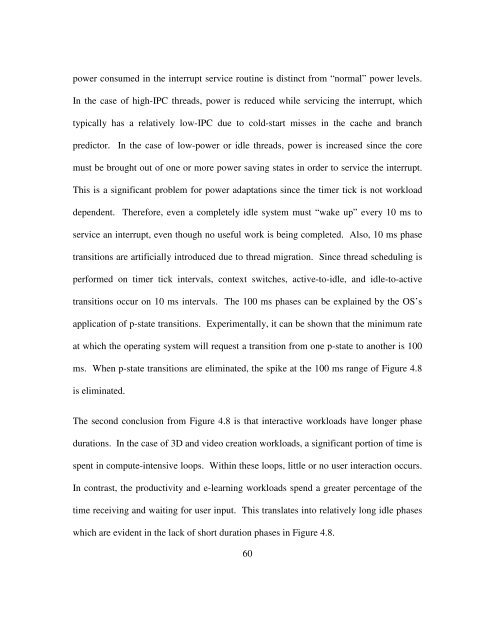Copyright by William Lloyd Bircher 2010 - The Laboratory for ...
Copyright by William Lloyd Bircher 2010 - The Laboratory for ...
Copyright by William Lloyd Bircher 2010 - The Laboratory for ...
Create successful ePaper yourself
Turn your PDF publications into a flip-book with our unique Google optimized e-Paper software.
power consumed in the interrupt service routine is distinct from “normal” power levels.<br />
In the case of high-IPC threads, power is reduced while servicing the interrupt, which<br />
typically has a relatively low-IPC due to cold-start misses in the cache and branch<br />
predictor. In the case of low-power or idle threads, power is increased since the core<br />
must be brought out of one or more power saving states in order to service the interrupt.<br />
This is a significant problem <strong>for</strong> power adaptations since the timer tick is not workload<br />
dependent. <strong>The</strong>re<strong>for</strong>e, even a completely idle system must “wake up” every 10 ms to<br />
service an interrupt, even though no useful work is being completed. Also, 10 ms phase<br />
transitions are artificially introduced due to thread migration. Since thread scheduling is<br />
per<strong>for</strong>med on timer tick intervals, context switches, active-to-idle, and idle-to-active<br />
transitions occur on 10 ms intervals. <strong>The</strong> 100 ms phases can be explained <strong>by</strong> the OS’s<br />
application of p-state transitions. Experimentally, it can be shown that the minimum rate<br />
at which the operating system will request a transition from one p-state to another is 100<br />
ms. When p-state transitions are eliminated, the spike at the 100 ms range of Figure 4.8<br />
is eliminated.<br />
<strong>The</strong> second conclusion from Figure 4.8 is that interactive workloads have longer phase<br />
durations. In the case of 3D and video creation workloads, a significant portion of time is<br />
spent in compute-intensive loops. Within these loops, little or no user interaction occurs.<br />
In contrast, the productivity and e-learning workloads spend a greater percentage of the<br />
time receiving and waiting <strong>for</strong> user input. This translates into relatively long idle phases<br />
which are evident in the lack of short duration phases in Figure 4.8.<br />
60




